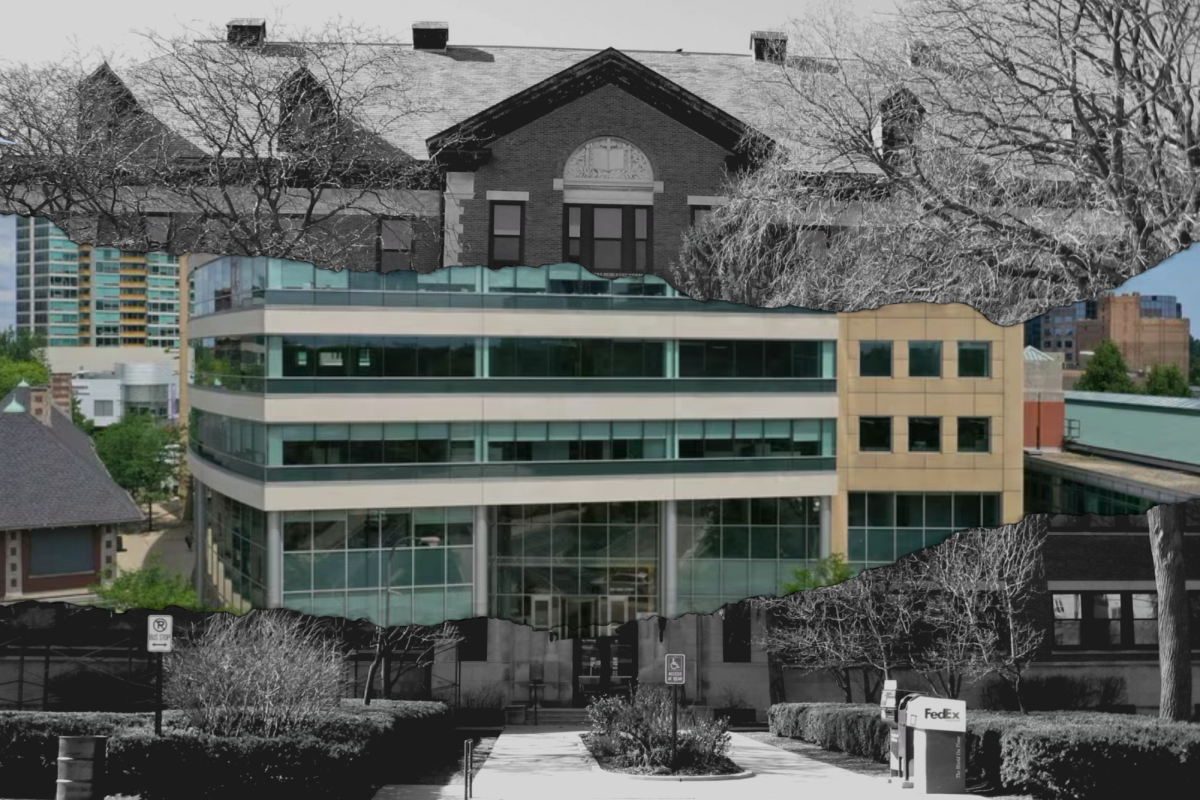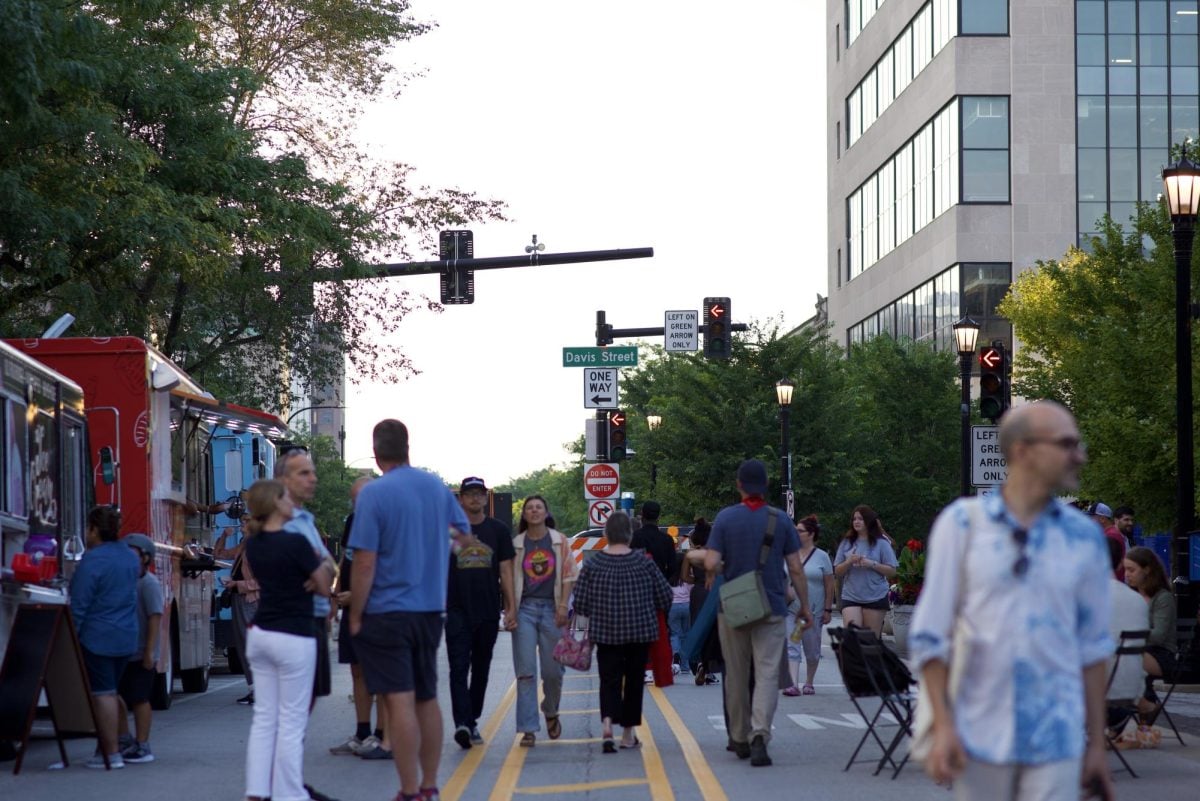Growing up in Evanston in the 1980s, Emilio Vargas remembers the Lorraine H. Morton Civic Center as the building at the center of the city. His mother would bring him to art shows, book fairs and other events. Now, as an adult, Vargas said he most recently went to the Civic Center to vote.
The city, however, is poised to leave the Georgian Revival-style building at 2100 Ridge Ave. — the building that has been the heart of Evanston civic life since 1979 — before the end of the year.
At its Jan. 22 meeting, City Council voted 6-3 to authorize City Manager Luke Stowe to lease 53,000 square feet of downtown office space at 909 Davis St. for about $2.4 million per year for city operations. Councilmembers also discussed options for renovating or relocating the Civic Center presented by the Chicago consulting firm AECOM, which the city contracted in late 2021.
Yet councilmembers decided the proposed lease will last 15 years, with an option to exit after seven. The city can begin using the downtown office in June if construction is completed, though the lease term officially starts in October.
“It’s just a building that is on its very last legs and at a very real risk of just failing,” Mayor Daniel Biss told The Daily. “And if we had not chosen to do the responsible thing of putting in place an exit plan and just waited for it to fail, then we would have been without city hall at all.”
A special order of business
The resolution to authorize the lease was on the City Council agenda as a special order of business, meaning it was not referred to the council by a committee.
The abruptness of the decision to lease has caught some community members off guard. They criticized the city for not considering alternative solutions that would allow the city to stay in the Civic Center during renovation.
Emily Guthrie, a longtime Evanston resident and a former 3rd Ward councilmember, said the issue came as a real shock for her.
“With what amounted to four days’ notice and vote on it the very same night, I can’t imagine why the City Council is in such a hurry,” Guthrie said.
Ald. Clare Kelly (1st), who voted against authorizing the lease along with Alds. Thomas Suffredin (6th) and Devon Reid (8th), agrees.
She said she is seriously concerned about the lack of transparency and public discussion around this “enormous move of enormous costs.”
“If leasing is the right course of action, then let’s do it. Let’s have public discussion,” Kelly said. “Why was this rushed through? I mean, everybody should be asking that question.”
But Biss disagrees. At the Jan. 22 council meeting, he said the special order of business came after an earlier executive session, where no binding decision was made and councilmembers gave him and city staff direction on negotiating the lease.
In the interview with The Daily, Biss said there has been robust discussion on the issue, and City Council was ready to move forward with a vote.
“We did it on (a) very normal timeframe, responsible timeframe, and I can’t imagine why we would have done it differently,” Biss said.
To move, or to renovate
Discussions about relocating city operations from the Civic Center date back to the 1990s, according to Evanston’s Capital Planning Bureau Chief Lara Biggs.
Originally the schoolhouse for Marywood Academy, a Catholic girls’ school, the building was sold to the city in 1975 for $1.5 million. The city then spent $750,000 on renovations, including adding in a new stairway, HVAC system and lighting, before moving operations into the new Civic Center in 1979.
But, barely two decades later, city staff began discussing whether investing more money to fully transform the building into an efficient workspace is the best use of the city’s funding, Biggs said.
“The city had not actually done a significant renovation of the building when we moved in,” Biggs said. “There are a lot of oddities in this building that actually in many ways give it character but are not conducive to efficient operation.”
In 2017, after a study on a possible replacement of the HVAC system estimated costs at $15 million, Biggs said she became more involved in the debate over moving versus renovating.
In the AECOM presentation at the Jan. 22 meeting, the consulting firm set the cost of renovating the Civic Center at roughly $63 million. Guthrie and Kelly both expressed concerns about the figure, which Guthrie called “seriously inflated,” and both felt signing a 15-year temporary lease was excessive. They said the renovation should cost much less, and could be completed in a much shorter time frame.
Since the Davis Street office space the city plans to lease is just over half of the size of the Civic Center, Guthrie and Kelly also questioned why the city did not consider a phased approach to renovation, leaving the city in the Civic Center.
Because of the state of the Civic Center, a renovation would require major overhauls of the building’s HVAC, plumbing and electrical systems, Biggs said, which explains why the cost exceeds that of a typical office renovation.
In addition, a renovation of this size and budget will retroactively require the renovated Civic Center to comply with building codes the city adopted after the building’s construction, including those for building structure and fire safety, Biggs said. The city also considered making the Civic Center compliant with the Americans with Disabilities Act and the city’s Climate Action and Resilience Plan.
For these reasons, the city has discussed a phased renovation but is not seriously considering the option at the moment, Biggs added.
“It is expected that that would significantly increase the cost of the construction, and it would take much longer,” she said. “During that time period, it would be disruptive to the staff and the city council and public doing work in this building.”
5,000 votes
Back in 2005, after a push from city officials to move city operations out of the Civic Center, 3rd Ward resident John Kennedy said he wanted to “save the Civic Center.”
“I was walking down the stairs, and I felt the building was solid. It almost talked to me,” Kennedy said. “I wasn’t a preservationist. I wasn’t an architect. I wasn’t a designer, but I just didn’t think this is the right way to go.”
Kennedy soon founded the Friends of the Civic Center group, which included Guthrie. The group began collecting signatures to put an advisory referendum on the ballot for the April 2007 elections, asking voters if the city should “rehabilitate and continue to reside in the Civic Center located at 2100 Ridge.”
About 5,000 people voted in the referendum, over 80% of whom voted in favor.
Biss called the referendum relevant to the city’s decision-making process, but not “dominant.” Although the referendum was non-binding — only City Council can place binding referenda on the ballot — he said the council responded to the residents’ will by staying at the Civic Center for an additional 17 years.
“Any data point related to public opinion is relevant, but I think a data point that is 17 years old on a subject matter that is relatively dynamic is one that has to be taken to the appropriate context,” Biss said.
However, Biss said he expects the city to begin public engagement on the long-term future of the Civic Center in order for City Council to make a permanent decision before the end of this year.
According to the presentation AECOM gave at the Jan. 22 council meeting, the city could spend between $120 and $159 million to renovate or relocate the Civic Center and to rebuild the police and fire headquarters.
“When you’re talking about numbers that size, you need to really ask not only what do you want, but how much are you willing to pay for it? And how do you prioritize the hierarchy of request?” Biss said.
“A majestic building”
At the Jan. 22 council meeting, several councilmembers said they support the lease. Ald. Jonathan Nieuwsma (4th) said moving city operations downtown could help revitalize the business district, and Ald. Bobby Burns (5th) said the location could help attract younger staffers.
“If we move out of here, I’m going to miss it,” Nieuwsma said during the meeting. “How much is that worth?”
Kennedy, however, pushed back on that argument. The city currently stays in the Civic Center “rent-free,” and renting an office downtown will take the space off the tax rolls.
Ultimately, Kennedy argued the Civic Center’s central location offers ample parking — and financial sustainability.
“It’s a majestic building. It’s certainly not an icon. It’s not [the] Taj Mahal. It’s not the Capitol. But it’s a stately building,” Kennedy said. “It has come to be associated with Evanston.”
Email: [email protected]
Twitter: @caseeey_he
Related Stories:
— City Council approves 15-year lease to temporarily relocate city center
— Civic Center Relocation Feasibility Project sparks discourse among Evanston residents














